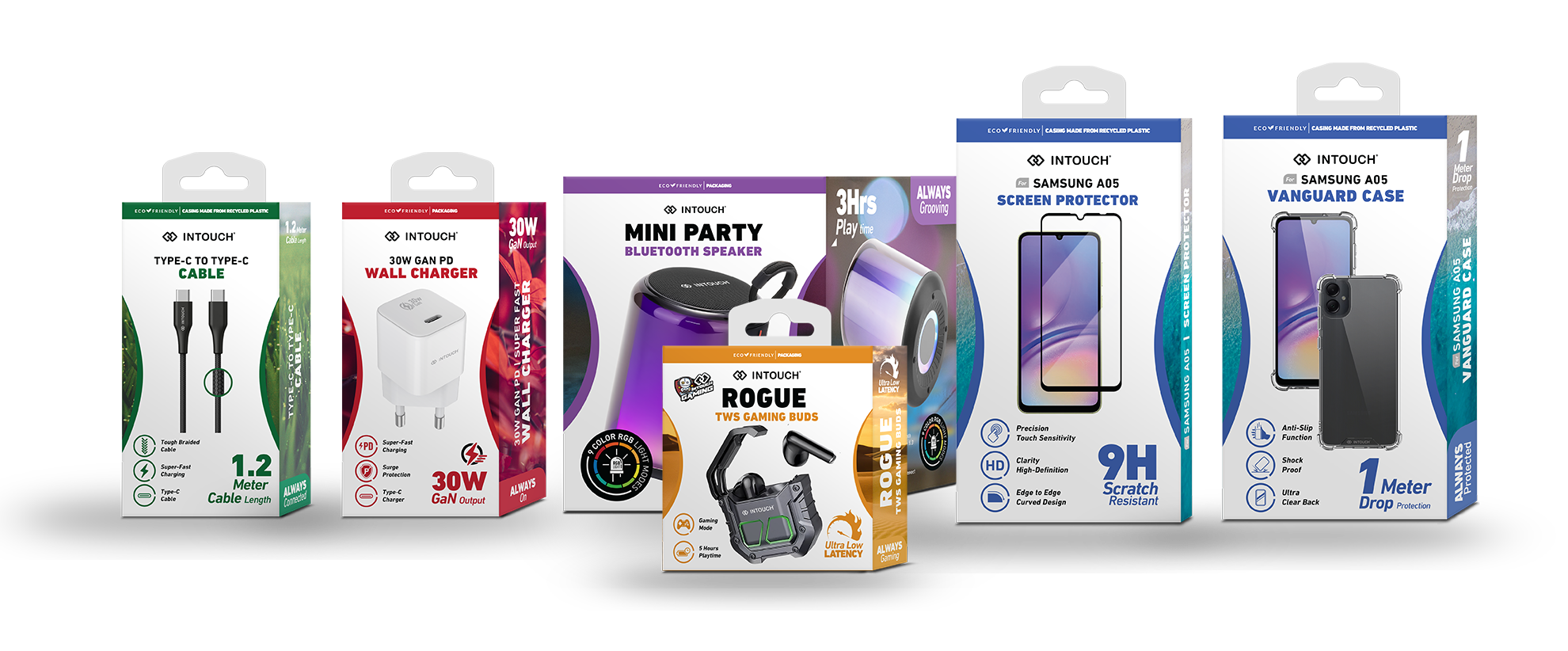
Meet Eco the Turtle, our adorable and lively brand mascot! With his infectious personality and charming demeanor, Eco is here to make a positive impact on the world and help raise awareness about plastic pollution and environmental conservation.
Eco the Turtle is the perfect embodiment of how we can approach environmental education in a fun and entertaining manner. By having Eco as our brand mascot, we aim to inspire and empower people to take action towards creating a cleaner and greener planet for generations to come.
ECO STORY
Eco-Friendly Packaging
Here at Intouch, we recognize that our operations and products have an impact on the environment, and we believe in a responsible approach to mitigating these impacts.
We aspire to infuse sustainability into our day-to-day work across the company, so that it shapes our thinking and the way we do business.
This is truly reflected with our New Eco-Friendly packaging, made from 100% recycled materials. We have moved away from using any plastics on our packaging as this has become a massive issue in today’s times.
Our Commitment to Sustainability
At Intouch, we believe that protecting the planet starts with the choices we make every day. That’s why we’re proud to announce that our packaging is now FSC® certified.
The Forest Stewardship Council (FSC) certification is an internationally recognized standard that ensures the paper we use comes from responsibly managed forests that provide environmental, social, and economic benefits.
When you see the FSC logo on our packaging, it’s more than just a symbol – it’s a promise. A promise that the materials we use help preserve forests, support local communities, and promote a healthier planet for future generations.
By choosing Intouch, you’re not only getting eco-friendly mobile accessories, but also joining us in making a positive impact on the environment.
Soy Ink is an eco-friendly printing ink developed in the late 1980s by the American Newspaper Association as a sustainable alternative to petroleum-based inks. Made from soybean oil, it quickly gained popularity for its environmental and printing advantages.
GRS certification was created to reduce the impact on people and the environment from the production of materials by driving a higher percentage of recycled content in products.
Environmentally Friendly – Derived from renewable soybeans, it reduces reliance on fossil fuels and produces fewer volatile organic compounds (VOCs).
Vivid Colors – Provides brighter, sharper, and more vibrant print quality compared to traditional inks.
Easier Recycling – Paper printed with soy ink is easier to de-ink, making the recycling process more efficient.
Originally drafted by the Control Union, and later handed over the ownership of this standard to the Textile Exchange. We finally followed GRS4.0 version after undergo several drafts GRS certification is international, spontaneity, performability, which can examine the ability of not only Recycling, Status of product, Social Responsibility, but the ability Environmental Protection and Restriction Of Chemicals for company. And it will be enhancing the “green“ competitiveness of the product.
GRS certification was created to reduce the impact on people and the environment from the production of materials by driving a higher percentage of recycled content in products.
The GRS certification also provides assurance for retailers and consumers that products are being made in a more sustainable way. The standard is managed with input from key stakeholders such as recyclers, suppliers, brands, and retailers all over the world.
GRS verifies that recycled materials are used, and it also tracks responsible production methods. Companies must demonstrate a chain of custody, and obtain certification from a professional third party that audits and validates each step of the supply chain.
Made With Wheat Straw Plastic
Imagine a world where you can now charge your phone with chargers and cables that are made from biodegradable parts? Now you can, with Intouch’s New Biodegradable Collection. These products are made from made from Wheat Straw Plastic.
What Is Wheat Straw Plastic?
Wheat straw plastic is the latest eco-friendly material and is a smart, environmentally friendly alternative to plastic. It is a premium food grade material and is completely BPA free and has FDA approval. The impact of regular plastic on the environment is devastating, and wheat straw plastic is an awesome alternative.
Wheat straw plastic is the latest eco friendly material and is a smart, environmentally friendly alternative to plastic. It is a premium food grade material and is completely BPA free and has FDA approval. The impact of regular plastic on the environment is devastating, and wheat straw plastic is an awesome alternative.
It is made from a by-product of wheat production, namely wheat straw. It has many applications like wheat straw food containers, wheat straw drinking straws, wheat straw plastic plates, reusable coffee cups and many more.
So what is wheat straw material? Wheat is a type of grain that is used to make flour, bread and wheat derived products like pasta. Wheat straw is the by product that is left over after the wheat harvest, and by using it to make a plastic like substance, it is an ideal zero waste option.
Wheat straw contains cellulose and by breaking it down, a new product can be created. The process creates the opportunity to make different kinds of polymers. Natural polymers are found in our bodies, like hair and nails. Plastic is made from artificial polymers, but polymers created from wheat straw, are completely natural.














